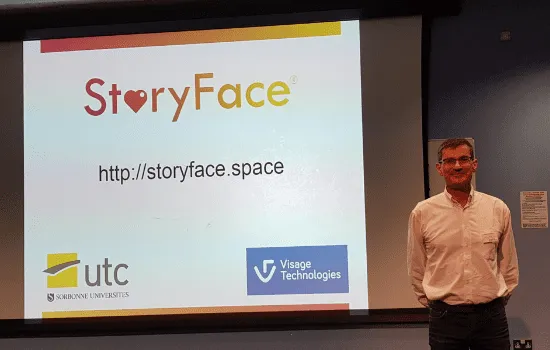PROTECT: Biometric border control improves security and eliminates queues
StoryFace: Fictional dating app based on emotion recognition

-
Client:
Compiegne University of Technology
-
Technology:
FaceTrack, FaceAnalysis
-
Use case:
Dating application based on emotion recognition
StoryFace is an artistic and pedagogical digital fiction application developed by two professors from the Compiegne University of Technology. It is primarily used for teaching purposes.
Business challenge
The client wanted to create an interactive digital fiction dating application based on emotion analysis. The app would track visitor’s emotions and adjust content accordingly. To be able to do so, the client needed software that could accurately track the person’s face and analyze it in real time. It had to provide accurate information about the person’s age, gender and emotions. That way, the app could suggest suitable fictional profiles for each specific visitor.
Solution
Face Track and FaceAnalysis were the ideal combination for the project. Together, they provided all the functionalities the application required:
- visage|SDK is extremely lightweight, delivering great results in real time with a broad range of cameras and resolutions
- FaceTrack detects and tracks human faces, including 99 facial landmarks
- FaceAnalysis estimates age, gender, and 7 basic emotions by default: happiness, sadness, anger, fear, surprise, disgust and neutral
- visage|SDK integration is very simple thanks to the detailed development guide and plenty of customization options
Results
The result of the project was StoryFace – a digital fiction dating application based on emotion recognition.
To use the app, users must have a web camera. After they log in, users need to display the emotion(s) that seem to characterize him/her the best. Based on those emotions, the website proposes profiles of suitable fictional partners. StoryFace also has a contributive dimension: anyone can create a fictional partner profile.
The user can browse through suggested profiles and choose a partner with whom they want to exchange messages. They are then expected to focus on the content of the messages while their facial expressions continue to be tracked and analyzed. They need to show their true feelings to continue the conversation.
The application highlights the tendency of emotion recognition devices to normalize emotions. Which emotion does the device expect? We go from the measurement of emotions to the standardization of emotions.